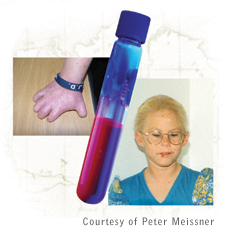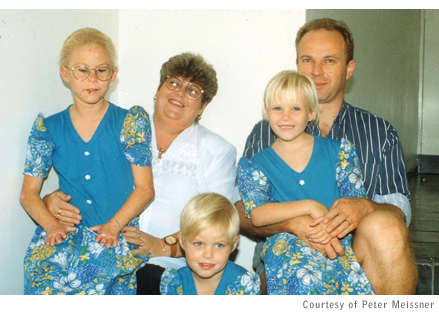


by Lauren Stancheck
Part 1 | Part 2


Part 2
Though symptoms do not usually appear until puberty, the severe condition of a 3-year-old South African girl named Lusinda led UCT researchers and Dailey to believe she had two copies of the mutation. This made her an ideal cell donor for the study.
In extreme cases like Lusinda’s, people may have little or no sensation in their fingertips and are unable to feel a hot stove or use a conventional computer keyboard.
With Lusinda’s cells and DNA, no matter which copy of the gene the scientists isolated, it would include the mutation responsible for her disease. They discovered two different mutations, one of which connected today’s South African population to a previously insignificant piece of history — the marriage of Dutch orphan Ariaantje Adriaanse to fellow Dutchman Gerritt Jansz van Deventer at Cape Town in 1688.
“The whole thing is a quirk of history,” Meissner said. “One of them carried a single, distinctive gene mutation that now constitutes 90 percent of the variegate porphyria cases in South Africa.”
“If you look around the world you’ll find that there are at least 50 mutations that have been identified that lead to variegate porphyria,” Dailey said. “This is fairly common for many genetic diseases where the cause is not a single mutation but any one of a whole variety of mutations.”
“It was a detective story that was sort of halfway done and we just added the molecular components to cap off the story,” Dailey said.
Finding the mutation opened the door for UCT researchers to develop neonatal screening. Thanks to that research, South Africans with variegate porphyria can now avoid the medications and chemicals that aggravate their condition and can prevent painful, life-disrupting symptoms before they ever develop.

“About 60 percent of the South African population carries the gene but most don’t know it because they are asymptomatic — it doesn’t show up in clinical symptoms,” Meissner said.
For his role in the project, UCT invited Dailey to return to South Africa as a Merrin Scholar, a prestigious honor UCT awards to one international scholar each year. Dailey continues to study the structure and function of enzymes associated with porphyria.
Their latest research involves transferring the porphyria gene into mice as a way to understand the variation in symptoms for individuals with the same mutation. Dailey and Meissner hope their newest collaboration will lead to an understanding of why the disease has such variation: acute symptoms, latent development or even no symptoms at all.
Dailey said he also hopes that the knowledge gained from the research on variegate porphyria and its spread through the South African population will one day help shed light on the nature of other genetic diseases.
“It’s not like anything exists in a vacuum,” Dailey said. “Everything has some connections and sometimes it’s surprising how a bit of information over here may end up popping up over there.”
For more information, contact hdailey@uga.edu
Lauren Stanchek, a science writing intern in UGA’s Research Communications Office, began her graduate studies in forensic science at Michigan State University in August.
For comments or for information please e-mail the editor: jbp@ovpr.uga.edu
To contact the webmaster please email: ovprweb@uga.edu
![]()